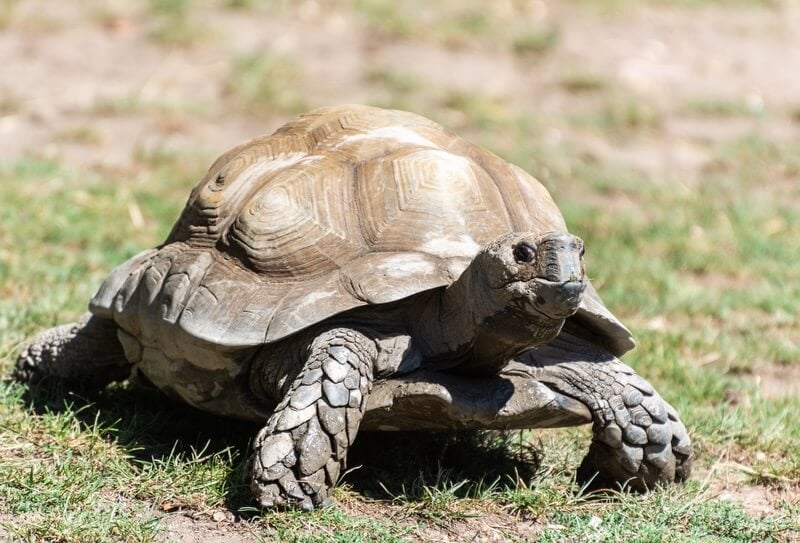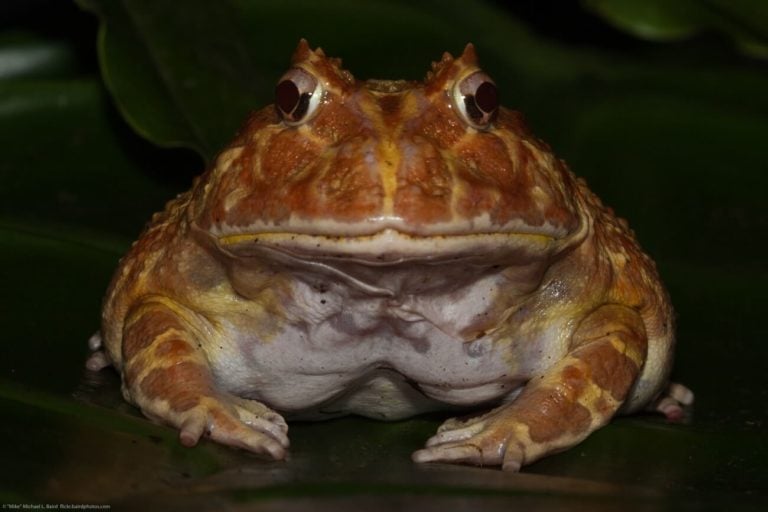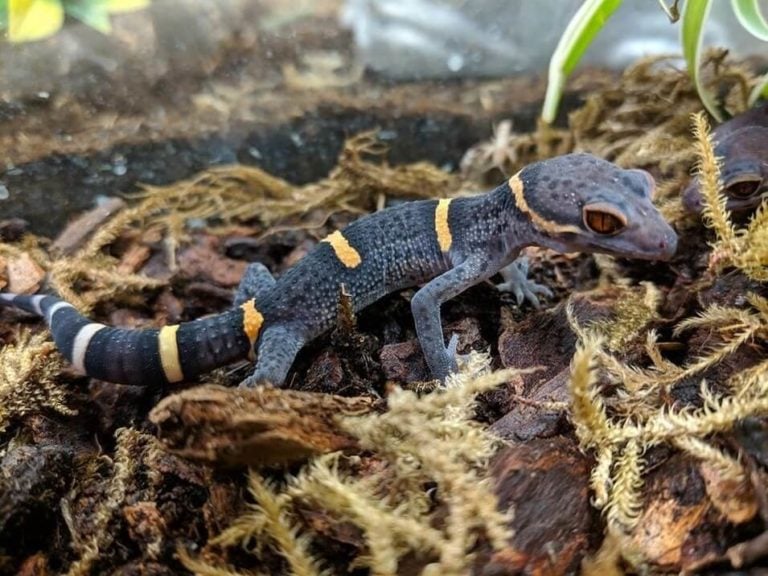Burmese mountain tortoises are large and fascinating reptiles. You can’t help but respect them once you see them up close!
In the guide below, we’ll cover the fundamentals of Burmese mountain tortoise care. You’ll learn about their size, diet, lifespan, and many other useful facts!
Table of Contents
Species Summary
The Burmese mountain tortoise (Manouria emys) is a beautiful chelonian that goes by many names. You might see these reptiles labeled as Burmese black tortoises, six-legged tortoises, Asian forest tortoises, and more. Whatever you call them, these tortoises are nothing short of impressive.
Native to Myanmar, Malaysia, Thailand, and Sumatra, the Burmese mountain tortoise is a protected species. While wild-caught specimens are available, most herpetology enthusiasts agree that captive-bred tortoises are a far better option. Not only do these critters not impact wild populations, but they’re also much healthier.
Like most large tortoises, this species is a slow and steady beauty. But despite what many believe, Burmese mountain tortoise care is relatively easy as long as you have the right resources.
Appearance & Colors
From a physical standpoint, Burmese mountain tortoises are rather basic. Their shells don’t exhibit any intricate patterns. Instead, scutes of brown, black, and tan adorn the backsides.
Like other tortoises, the shell is tall and dome-shaped. Meanwhile, flared scutes along the perimeter provide some protection against the elements and would-be predators.
Expert Tip: Technically speaking, there are two Burmese mountain tortoise subspecies. They’re nearly identical. The main difference is the plastron, which is either yellow-tinted or dark brown.
One exciting thing about the Burmese mountain tortoise is its skin. Protruding scales on the hind legs create the illusion of a complex limb system, which is how they get their nickname of “six-legged tortoise.” Scales cover the front legs, too, but they’re much flatter.
Lifespan
These tortoises are still relatively new to the pet trade. Experts believe that the typical Burmese mountain tortoise lifespan range is between 20 and 60 years. On the upper end of the lifespan range, many hope to see them surpass 60 years in captivity.
In the wild, these tortoises reportedly live over 100 years!
Of course, there are no guarantees with the lifespan of these animals. The quality of care you provide and uncontrollable factors like genetics all come into play.
Average Size
If you’re looking for a small and manageable tortoise, look elsewhere! Burmese mountain tortoises are the fourth largest tortoise species in the world!
The typical Burmese mountain tortoise size is about 70 pounds in the wild for full-size adults, but they can tip the scales at 100 pounds in captivity! They carry a lot of mass and can have a straight-line carapace length of about two feet.
Burmese Mountain Tortoise Care
The biggest challenge when it comes to Burmese mountain tortoise care is their large size. But if you have the space and resources, keeping these reptiles healthy isn’t as difficult as many would think.
This pet tortoise is relatively undemanding. As long as you meet the tortoise’s primary environmental and dietary needs, they should have no problem living long and happy lives.
Here are some care guidelines to get you started!
Enclosure Size
Most Burmese mountain tortoise owners will adjust the size of the enclosure as their pet grows.
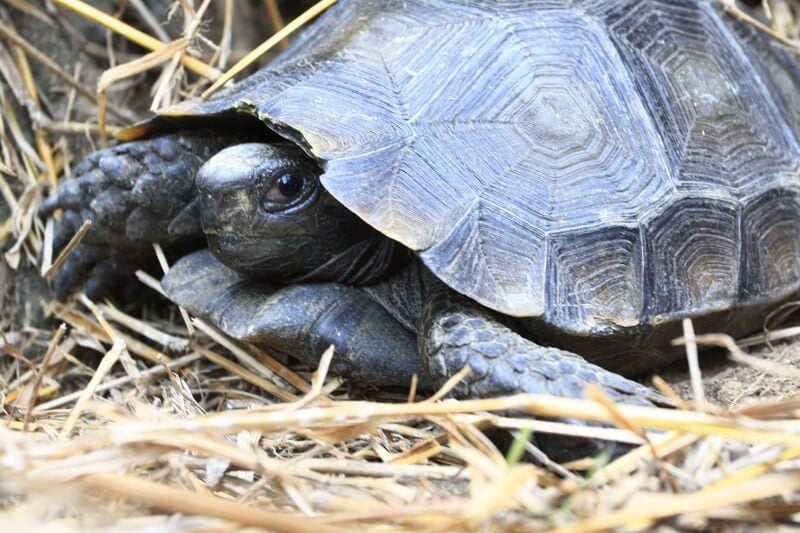
Young hatchlings and growing juveniles will do just fine in a 20 to 40-gallon terrarium. An open-top turtle table works well, too. A smaller habitat should suffice for the first couple of years.
As this reptile grows, you’ll need to upgrade. Full-grown adults will need an enclosure that’s at least 12 feet long by 12 feet wide. If you plan on keeping a group of tortoises, a habitat of 20 feet by 20 feet is more appropriate.
When it comes to height, about two and a half feet is all you need. These tortoises aren’t big climbers and cannot scale vertical surfaces. They’re not big diggers either. Though, it’s still a good idea to bury part of the wall for extra measure.
Expert Tip: This species can live indoors or out, depending on your local climate. For outdoor enclosures, make sure to use solid fence walls that don’t let your tortoise see through them.
What To Put In Their Habitat
Because they need high humidity levels, start with a layer of absorbent substrate material. A mix of fir, sphagnum moss, peat moss, and cypress mulch works well. They do a fine job of raising the humidity. Plus, the substrate won’t cause issues if your tortoise eats some of it.
For the decorations, you can add items like logs, clay pots, and plants. Hostas are a good choice for plants. However, you can mix and match to provide shelter and sun coverage. That’s especially important for outdoor enclosures.
It’s a good idea to add two large hide boxes as well. One should be on the basking side of the enclosure while the other is on the cool end.
Temperature & Lighting
If you’re keeping your Burmese mountain tortoise outside, lighting and temperature needs are pretty easy to meet. These reptiles require ambient temperatures between 50 and 80 degrees. Outdoor living is ideal if you live in a humid area like the southern United States.
If temperatures aren’t suitable where you live, you can set up shop indoors. Temperatures should be around 70 degrees on the cooler end of the habitat. With a basking lamp, raise the temperature to about 85 degrees in one corner.
Like most reptiles, Burmese mountain tortoises thermoregulate by moving in and out of the sun. So, having a temperature gradient is a must.
Even if your tortoise lives outside, they can benefit from artificial heat sources to provide a little stability. Indoor tortoises will also need a UV lamp. Install a 5-percent UVB lamp to shine on as much of the enclosure as possible. It stimulates sunlight and encourages your tortoise’s body to synthesize calcium naturally.
Humidity
One of the most important parts of Burmese mountain tortoise care is humidity. To stay healthy, these tortoises need between 60 and 100 percent humidity (80 percent is ideal). Use a digital hygrometer to monitor those levels regularly.
Expert Tip: If you need help raising and maintaining the humidity, spray the enclosure down once or twice a day. You can also install an automatic sprinkler to keep the air nice and damp for your tortoise.
Water
Another feature that could maintain humidity levels is a water dish.
Burmese mountain tortoises need a water dish in their enclosure. While they rarely drink from it, many will soak in it to cool off and hydrate.
Utilize a large dish that the tortoise can easily crawl in and out of when they feel like it. The receptacle should be shallow to avoid drowning. However, it needs to have ample water for cooling, too.
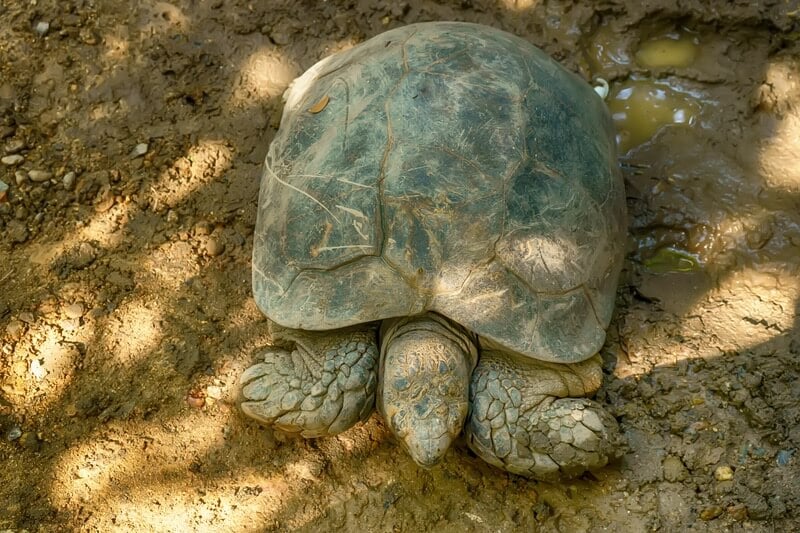
Keep an eye on the water and replenish it regularly. Don’t be surprised if the tortoise defecates in it. Simply clean it out and provide some fresh water.
Expert Tip: If you want to take things a step further in an outdoor enclosure, install a water feature! Waterfalls and fountains are a great way to support the environment while providing enrichment.
Burmese Mountain Tortoise Food & Diet
Burmese mountain turtles are omnivores that thrive on varied diets of protein and plant-based foods.
Leafy greens and vegetables should make up most of their diet. You can provide:
- Dandelion
- Kale
- Romaine lettuce
- Mustard greens
- Turnip greens
- Collard greens
- Chicory
- Endive
- Zucchini
- Carrots
- Bok choy
- Palm leaves
- Hibiscus
Fruits can make up about 10 percent of the tortoise’s diet. Melons, pears, bananas, and other common fruits are suitable. The only thing to steer clear of is citrus, which could cause an upset stomach.
Protein should be limited to about 15 percent of their diet at most. You can give them everything from lean meats to insects. Some good protein options include:
- Mealworms
- Earthworms
- Crickets
- Pinkie mice
- Lean chicken
- Beef
Generally, plant-based foods are suitable for everyday meals. Meanwhile, proteins are best two or three times a week.
Expert Tip: If keeping your tortoise indoors, provide Vitamin D3 and calcium supplements a few times a week. Outdoor tortoises will only need calcium supplements.
Potential Health Issues
One of the reasons Burmese mountain tortoise care is fairly easy is that these are generally healthy reptiles.
However, they can succumb to all of the usual reptile health ailments if you’re not careful. This includes respiratory infections from improper temperature or humidity levels, metabolic bone disease from a lack of calcium, and bacterial infections from a dirty environment.
Stay on top of habitat conditions. Spot-clean regularly and sanitize the entire area every four to six weeks to manage bacteria.
Expert Tip: Captive-born Burmese mountain tortoises are usually healthy from birth, which is why it’s always recommended to adopt them. If you get an imported tortoise, there’s a good chance that it’s rife with parasites and disease by the time you get it home.
Behavior & Temperament
At first, young Burmese mountain tortoises are shy. Beyond scavenging for food, they’ll spend most of their days in hiding.
Thankfully, these creatures come out of their shells by the time they mature into adults (no pun intended). Adult tortoises are familiar with you and the environment. So, they’re less fearful and more eager to explore.
You can find them investigating every corner of the enclosure. These chelonians might be slow, but that doesn’t stop their inquisitive nature.
Burmese mountain tortoises are crepuscular, so they’re more active at dusk and dawn. Between those times, most are going to relax and spend time getting comfortable.
Handling Them
Because of their sheer size, these tortoises aren’t keen on handling. They’ll put up with quick bouts of handling when you need to clean the enclosure. But beyond that, they might show signs of agitation.
That means part of responsible Burmese mountain tortoise care is practicing restraint and respecting their preferences. This species is best treated as an observation pet. You can get up close and personal if the tortoise is comfortable with you. However, it’s better to keep handling to a minimum.
Conclusion
Burmese mountain tortoise care shouldn’t intimidate you. In fact, you should find success as long as you follow the recommendations above.
Let us know if you have any questions or concerns about owning this species. We’re always happy to help prepare you for the ownership process!

